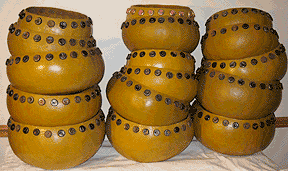
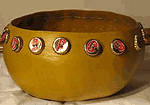 |
 |
 |
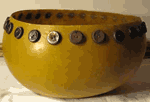 |
|
10" |
13" |
14" |
15" |
Fiberglass Dezes: four sizes: these come in four sizes: 10, 13, 14, 15" diameter.
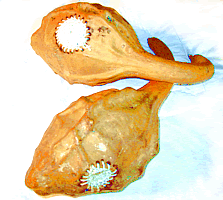
Hosho (calabash rattles): These are our authentic Zimbabwe rattles filled with hota seeds for a distinctly consistent sound. Each gourd is carefully dried and all seeds removed, inner gourd lining is carefully removed using hot water. After the cleaning, and drying, a carefully measured amount of hota seeds are added and the gourd opening is closed with a crotched patch using white yarn. Another kind of hosho is made out of the dried shell of the wild orange (damba or matamba[plural]). They are each filled with small river- bed pebbles or hota seeds. A short stick is used as a harness to keep them together as well as being used as a handle. This type of hosho is not as loud as the pumpkin gourd version, making it ideal for recording sessions. Often, the larger pumpkin version hosho can be loud enough to overwhelm the mbira in a performance or recording session.
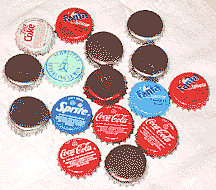
Bottle-tops: Yes, in the spirit of keeping it originally Zimbabwean, we are happy to present out Zimbabwe bottle-tops ¯ yes, Coca-Cola, Fanta, Lion Larger, Castle Lager, Black Label, Schweppes Sparkling Lemon, Sprite and Crème Soda. Bottle-tops, a replacement for snail-shells make an integral part of the mbira sound. Today, many mbira makers affix to the mbira a metal plate upon which a number of bottle tops are attached. These bottle-tops vibrate uniquely in sympathy with each of the the keys on the instrument thereby providing a percussive element to the music.
Resonator gourds, be they calabash or fiber-glass, are also adorned with bottle-tops to produce the same effect. Bottle-tops are sold as a basket of 20 bottle-tops. For more information e-mail solomon.murungu@zambuko.com. Unfortunately no special brand requests, we provide a random sampling of these bottle-tops.
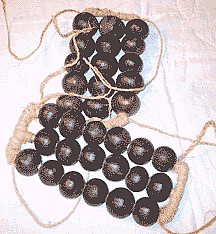
Magavhu (leg rattles) or Magagada: These
consist of a number of empty dry pumpkin (mapudzi)
marrows that are filled with hota seed and arranged
in series of anywhere from four to six. They
are bound together using bark fibre from the
mupfuti tree. During performance, they are tied
to one's ankles and they accompany the rhythm
of the dance in unison with hosho or drum (ngoma).